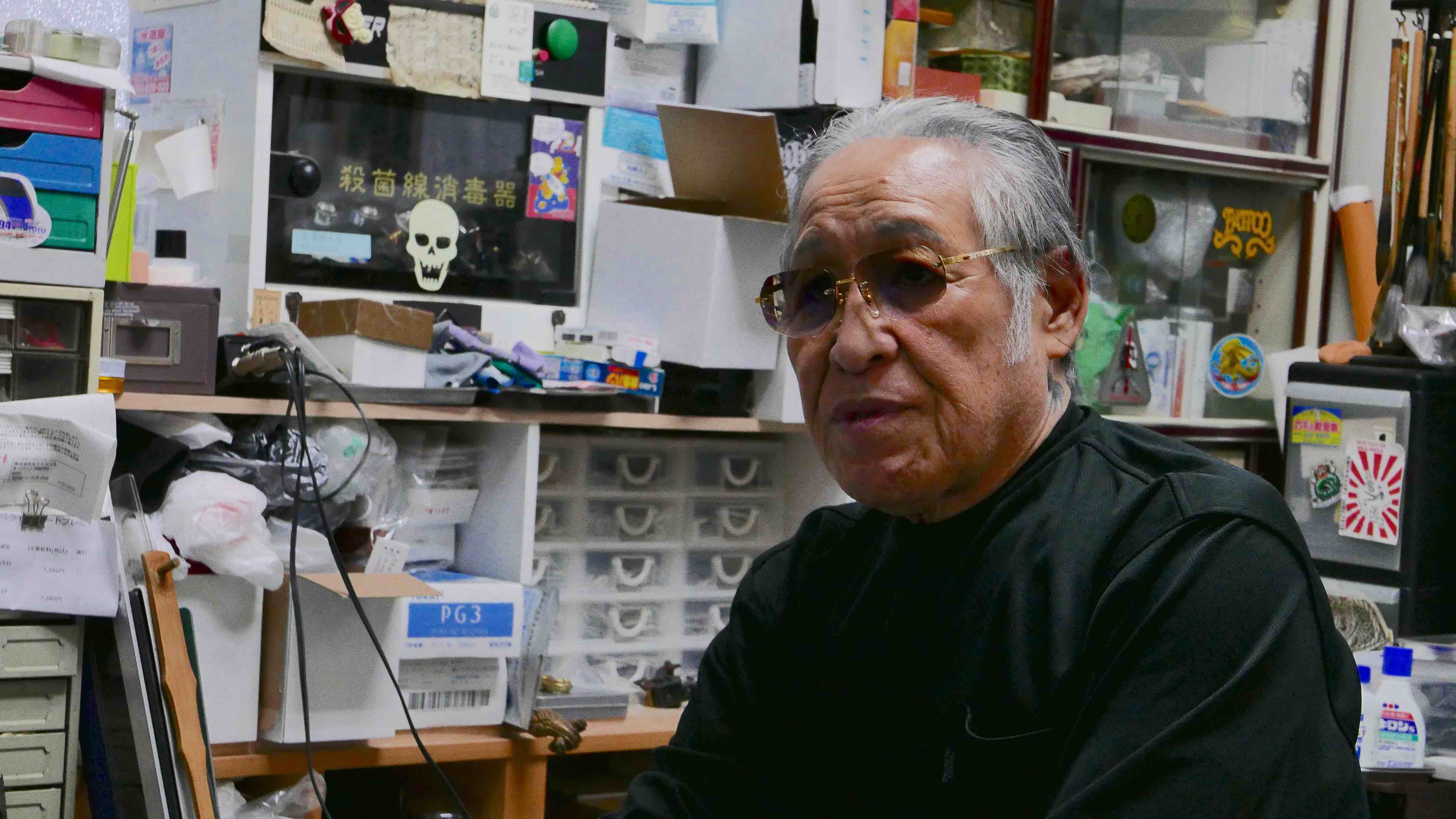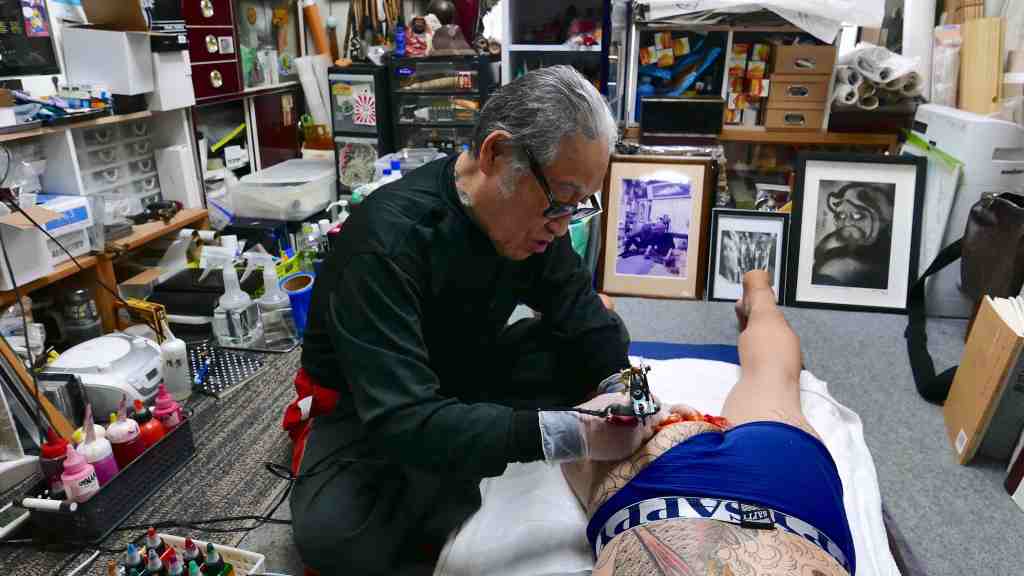Growing up in a conservative Muslim household, if any of my cousins had tattoos they always had to keep them hidden. Tattoos were both a religious and cultural taboo. I remember when my uncle visited us from America, every time he reached over the dinner table our eyes went to the black lines crawling from the bottom of his pullover. They were a mystery to us, although we could see they had some kind of spiritual significance to him.
These days my skin is inked with the names of murdered friends, a portrait of Gaddafi, dates of imprisonment, and a 1%er diamond. I got my tattoos knowing wholeheartedly that my closest family members would only see them during the Islamic ritual of bathing the body before burial. I wanted my ink to form a visual portrait of ideas and events that transfigured me, literally and spiritually.
Videos by VICE
So do we get tattoos for ourselves, or to flaunt in front of others? In the West it’s probably a bit of both. And that’s why I’ve always found the Japanese Yakuza’s take on tattoos so fascinating. They believe that tattoos are private, and so they’ll commit to full body-suits that can’t be seen above any collars or cuffs. And in this way, the humility of Japanese society has restrained tattoo culture from interrupting public life.

Of all the tattoo artists in Japan, Horiyoshi 3 is probably the most legendary. He’s an Irezumi tattooist based in Yokohama, and he’s also the favoured tattooist of the Yakuza—the Japanese mafia.
It was raining when I caught the train to visit Horiyoshi 3. I was greeted at the door of his studio by two men in Burberry suits and led inside where Horiyoshi was transfixed on the job. I couldn’t understand their intermittent growls in Japanese. They kept slapping the ground as if they were backhanding the carpet. Horiyoshi was silent. He didn’t acknowledge us for over an hour. The buzzing silence was kind of meditative.
The men were members of the local Yakuza family. Horiyoshi was tattooing a bright red Koi fish on their boss, a greying man in a red Champion tracksuit. They offered me a cigarette, I anxiously asked them if I should step outside to smoke. The buzz from Horiyoshi’s needle stopped abruptly as he began to chuckle, as if waking from a lucid dream. “Relax, stay and smoke.”
VICE: So why do you think Yakuza members like to be tattooed by you?
HORIYOSHI 3: Yakuza always want the best, everything must be first class. Whatever they wear, the places they hang out, the women they walk with, and the cars they drive. They have a lot of pride. And they want to look good, so they come here.
In the West, when we think of Japanese men in full body suits, the first thing we think of is the Yakuza.
The way tattoo culture is connected to the Yakuza or criminal world has a lot to do with journalism. When little kids are raised, they’re going to read about the Yakuza and think that they are bad people. But I know them personally. They do a lot of good things for our community. When the earthquake happened they responded with aid faster than the government. Everyone left their homes and it was the Yakuza that insured that nobody would be burgled.

I read that criminals were often punished by tattoos in the Edo period?
In the Edo period criminals would get the symbol of Tokugawa on the back of their necks to avoid the death penalty. But then the officials would just hack the skin off before they executed them. If you tattoo a family symbol it is a very serious crime, almost as bad as tattooing a first generation samurai symbol.
In Japan, these symbols hold deep connotations. Criminality doesn’t interest us. Neither does plastic intimidation. We don’t get tattoos to show off masculinity. A lot of our designs contain a scene from a story. If you wear the symbols of punishment as a tattoo it’s not cool because it means you got arrested for something small. In the Edo period, if you committed a serious crime you would have your head cut off. It’s weird talking about what’s cool when we talk about crime.

Does the Yakuza feel that these scenes from Japanese mythology express who they really are, outside of propaganda-fuelled stereotypes?
If the Yakuza want to use tattoos to show the public that they’re in a gang, they will simply wear visible tattoos and say they are Yakuza. But they’re not that stupid. I don’t think they get their tattoos with their allegiance to the Yakuza in mind. People sometimes refer to Yakuza through the word ninkyō which actually means helping people below you. Yakuza are trying to help people that’s what it is traditionally about. The tattoos are to show that they have the strength to help the weak. But it doesn’t need to be made public.

Do you ever refuse tattoos?
Yes, I never tattoo above the neck or on hands. I believe the beauty is in what you can’t see. What you think is beautiful is different for each person. It might be something to do with the depths of your personal history and culture. The Japanese aesthetic is very unique in comparison to that of the West. If you think about seppuku (ritual Japanese suicide), we have an aesthetic quality to suicide and death. It’s precise, simple, fragile, bold, and heavy. Tea ceremonies, flower arrangements, samurai swords—there’s a very conscious style at play.
Why do you think it is important for tattoos to be hidden?
Tattoo culture in Japan is still a taboo, but that’s why the culture is beautiful. Fireflies can only be seen at night. Their beauty is only visible at night. It isn’t appreciated in daylight. When something becomes a fashion, it isn’t fascinating anymore. In Western culture it might just be fashion or trendy, but in Japan we appreciate tattoos you can’t see and that’s why we think they’re beautiful, it’s hidden. Japanese culture is about being in the shadows.
Western churches are bright and opulent but our temples are quite dim and dark. In Japanese culture we depict the light by exploiting the shadows. The shadow of the buddhas are more important than the faces of sculptures. People get tattoos here knowing they won’t be showing them off all the time and that’s why we don’t take our tattoos lightly. Our spiritual culture is different from other countries because when we show our tattoos, it takes the form of a mysterious light that’s hidden and beautiful. That’s why it’s fascinating.

I think this idea of being drawn to darkness is interesting.
It’s human nature for people to be attracted to dark places. Even at night when the moon is out, we seem lured in by the superstition of darkness in the night. It’s human nature. Japanese people are really good at using the shadow to make sense of the light. Maybe in Western culture, they start with the light and try to understand their shadows. In Japan, to draw what the light represents, we exploit the traditions of the shadows.
In our culture we have a form of musical theatre called Noh, it predates electricity in Japan. They would make a bonfire and perform theatre around the fire. It’s not like a spotlight, you can’t really see the action perfectly but the costumes shimmer in front of the flames, outfits laced with gold or silver thread. If the scenes were perfectly lit you might just see gold thread, but the drama of the shimmering light really comes alive in the dark.
Japanese architects are always thinking about shadows and the position of the sun as it lights the blinds. The positioning of the blinds is very important in Japanese homes.
Shige asked me to visit the Sankeien gardens, it felt more like art than architecture.
Yes, the architects would calculate each month of the year so they could paint the landscape using shadows, lights, and seasons. It’s not just about tattoos. Even when you look into the ocean and you see the reflection of the moonlight on the waves, it looks quite mysterious and beautiful but when you go during the day the sea is quite bright but it doesn’t resonate with mystery.

Why do you refuse to call yourself an artist?
I’m not going to deny it. I’m an artisan and if people want to call it art then that’s their business. I’m a craftsman. There is a famous sculpture called sleeping cat, nemuri-neko. They call it a great work of art but I don’t know if the sculptor intended it to be art. Because he was a craftsman. I’m sure he never said he was an artist.

People always ask me about what I think art is. I don’t know where the borderline is for the standard of art. In traditional Japanese scrolls, the ultimate form of art for that medium is when there is no painting on the scroll. There’s a beauty in the space and the spectator should imagine what’s art.
In regards to modern art, if someone famous picks rocks up off the sidewalk and places them in a big gallery that’s also art. The descriptions of it become art too. Castles, swords, pottery it’s all art. Where are the borderlines? I personally think Japanese tea ceremonies are art. I can’t tell what art is anymore. It depends on who picks it up? Who has value nowadays? What has value?
Follow Mahmood on Instagram
More
From VICE
-

Screenshots: Electronic Arts, AdHoc Studio -

Screenshot: Savage Level -

Screenshot: Electronic Arts -

Screenshot: Megabit Publishing
